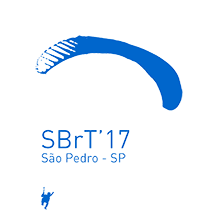
XXXV Simpósio Brasileiro de Telecomunicações e Processamento de Sinais
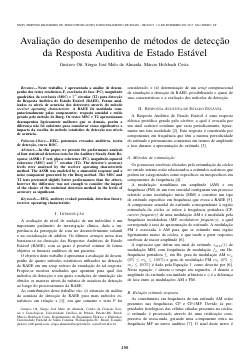
Avaliação do desempenho de métodos de detecção da Resposta Auditiva de Estado Estável
Gustavo Ott, Sergio Jos é Melo de Almeida, Márcio Holsbach Costa
DOI: 10.14209/sbrt.2017.188
Keywords: EEG auditory evoked potentials detection theory receiver operating characteristic
Abstract
In this paper, we present the performance analysis of four statistical detection tests for the Auditory Steady-State Response (ASSR): F test, phase coherence (PC), magnitude-squared coherence (MSC) and T 2 circular (T2). The detector’s accuracy levels were analyzed by the receiver operating characteristic method. The ASSR was modeled by a sinusoidal response and a noise component generated by the Burg method. The MSC and T2 tests presented slightly better performances than the others, however the difference was not enough to consider the impact of the choice of the statistical detection method in the levels of accuracy as significant.Download

Verification of Magnitude and Phase Responses in Fixed-Point Digital Filters
Daniel P. M. de Mello, Mauro L. de Freitas, Lucas C. Cordeiro, Waldir S. S. Junior, Iury V. de Bessa, Eddie B. L. Filho, Laurent Clavier
DOI: 10.14209/sbrt.2017.189
Keywords:
Abstract
In the digital signal processing (DSP) area, one of the most important tasks is digital filter design. Currently, this procedure is performed with the aid of computational tools, which generally assume filter coefficients represented with floating-point arithmetic. Nonetheless, during the implementation phase, which is often done in digital signal processors or field programmable gate arrays, the representation of the obtained coefficients can be carried out through integer or fixed-point arithmetic, which often results in unexpected behavior or even unstable filters. The present work addresses this issue and proposes a verification methodology based on the digital-system verifier (DSVerifier), with the goal of checking fixed-point digital filters w.r.t. implementation aspects. In particular, DSVerifier checks whether the number of bits used in coefficient representation will result in a filter with the same features specified during the design phase. Experimental results show that errors regarding frequency response and overflow are likely to be identified with the proposed methodology, which thus improves overall system’s reliability.Download
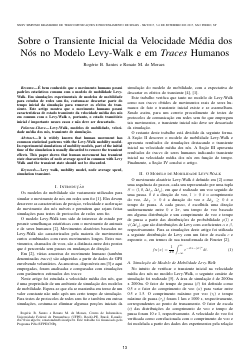
Sobre o Transiente Inicial da Velocidade Média dos Nós no Modelo Levy-Walk e em Traces Humanos
Rogério B. Santos, Renato M. de Moraes
DOI: 10.14209/sbrt.2017.184
Keywords: Levy-Walk modelos de mobilidade velocidade média dos nós transiente de simulação
Abstract
É bem conhecido que o movimento humano possui padrões estatísticos comuns com o modelo de mobilidade LevyWalk. Em simulações experimentais de modelos de mobilidade para estudos de redes sem fio, costuma-se descartar parte do tempo inicial da simulação para remover os efeitos do transiente. Este artigo mostra que o movimento humano possui características de estado transiente da velocidade média dos nós em comum com o Levy-Walk e, portanto, o estado transitório inicial é importante nesses casos e não deve ser descartado.Download

Estimação DOA usando SEAD e Nelder-Mead Simplex
Lucas Rodrigues Ferreira, Rodrigo Pinto Lemos
DOI: 10.14209/sbrt.2017.190
Keywords: DOA ED Nelder-Mead SEAD
Abstract
Antenas inteligentes são fundamentais nos sistemas móveis de última geração, pois conseguem mitigar interferências e rastrear usuários pela estimação das direções das frentes de onda incidentes. O estimador MODEX é muito difundido mas tem seu desempenho degradado em baixas relações sinal-ruído, devido a empregar a função objetivo de máxima verossimilhança. O SEAD utiliza a mesma função objetivo mas alcança melhor desempenho de estimação pois se baseia no espectro diferencial que é menos susceptível ao ruído. Assim, este trabalho propõe uma nova função objetivo baseada exclusivamente no espectro diferencial para melhorar o desempenho do SEAD em baixas relações sinalruído.Download
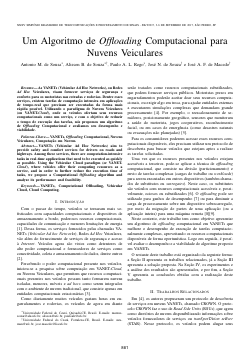
Um Algoritmo de Offloading Computacional para Nuvens Veiculares
Antonio M. de Sousa, Alisson B. de Souza, Paulo A. L. Rego, José N. de Souza, José A. F. de Macedo
DOI: 10.14209/sbrt.2017.185
Keywords: VANETs Computational Offloading Vehicular Cloud Cloud Computing
Abstract
VANETs (Vehicular Ad Hoc Networks) aim to provide safety and comfort services for drivers on roads and highways. Among these services, there are computation-intensive tasks in real-time applications that need to be executed as quickly as possible. Using the Vehicular Cloud paradigm (or VANET- Cloud), where vehicles offer their computing resources as a service, and in order to further reduce the execution time of tasks, we propose a Computational Offloading algorithm and analyze its performance and feasibility.Download

Analysis of the Correntropy-Based Criterion for Blind Equalization with Precoded Sources
Vinícius A. de Oliveira, Denis G. Fantinato, Rafael Ferrari, Romis Attux, Levy Boccato
DOI: 10.14209/sbrt.2017.191
Keywords: Adaptive filtering Blind channel equalization Information-theoretic learning Correntropy
Abstract
Temporally structured sources may arise in blind equalization as the result of coding schemes. In this context, a promising approach involves the use of correntropy, which is capable of exploring both the statistical information and the temporal structure of the signals. In this work, we perform a detailed analysis of the correntropy-based criterion for equalization, giving a special attention to the effect of the adjustable parameters as well as to the comparison with the analytical correntropy measure, whose formal derivation is another contribution of this work. The experimental results indicate the attainable performance and the influence of the main parameters.Download

Estimation of Directed Information to Processes Assuming Continuous Values with CTW Algorithm
Juliana M. de Assis, Francisco M. de Assis
DOI: 10.14209/sbrt.2017.192
Keywords: Directed information Causality Estimation Dis- cretization
Abstract
This paper introduces the use of a directed infor- mation estimator for discrete-valued processes to continuous- valued processes by previously discretizing the continuous-valued processes according to three different and generally applicable methods. The directed information estimator uses context tree weighting algorithm (CTW). The three discretization methods are called equidistant, equipopulated and symbolic methods. Simu- lated results indicate that faster and more conservative results are found by using few discretization levels with equipopulated method.Download
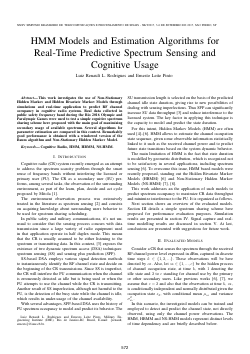
HMM Models and Estimation Algorithms for Real-Time Predictive Spectrum Sensing and Cognitive Usage
Luiz Renault L. Rodrigues, Ernesto Leite Pinto
DOI: 10.14209/sbrt.2017.170
Keywords: Cognitive Radio HMM HBMM NS-HMM
Abstract
This work investigates the use of Non-Stationary Hidden Markov and Hidden Bivariate Markov Models through simulations and real-time application to predict RF channel occupancy in cognitive radio systems. Real data collected in public safety frequency band during the Rio 2016 Olympic and Paralympic Games were used to test a simple cognitive spectrum sharing scheme here proposed with the main goal of maximizing secondary usage of available spectrum. Several algorithms for parameter estimation are compared in this context. Remarkably good performance is obtained with a windowed version of the Baum algorithm and Non-Stationary Hidden Markov Model.Download
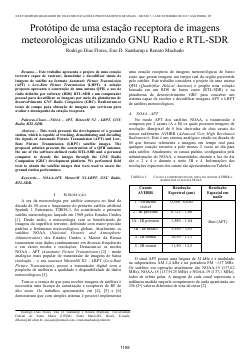
Protótipo de uma estação receptora de imagens meteorológicas utilizando GNU Radio e RTL-SDR
Rodrigo Dias Flores, Eno D. Saatkamp, Renato Machado
DOI: 10.14209/sbrt.2017.171
Keywords: NOAA - APT MeteorM N2 - LRPT GNU Radio RTL-SDR
Abstract
Este trabalho apresenta o projeto de uma estação terrestre capaz de rastrear, demodular e decodificar sinais de imagens de satélite no formato Automatic Picture Transmission (APT) e Low-Rate Picture Transmission (LRPT). A solução proposta apresenta a construção de uma antena QFH, o uso de rádio definido por software (RDS) RTL-SDR e um computador pessoal para decodificar as imagens por meio da plataforma de desenvolvimento GNU Radio Companion (GRC). Realizaram-se testes de campo para obtenção de imagens que serviram para avaliar o desempenho da estação receptora.Download
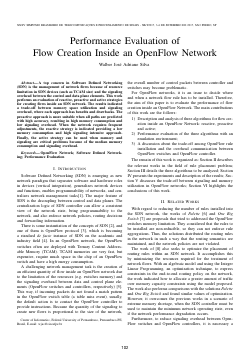
Performance Evaluation of Flow Creation Inside an OpenFlow Network
Walber Jose Adriano Silva
DOI: 10.14209/sbrt.2017.269
Keywords: OpenFlow Network Software Defined Networking Performance Evaluation
Abstract
A top concern in Software Defined Networking (SDN) is the management of network flows because of resource limitation in SDN devices (such as TCAM size) and the signaling overhead between the control and data plane elements. This work performs an evaluation of reactive, proactive and active strategies for creating flows inside an SDN network. The results indicated a trade-off between memory space utilization and signaling overhead, where each approach has benefits and drawbacks. The proactive approach is more suitable when all paths are predicted with high accuracy, resulting in high memory consumption and low signaling overhead. When the network requires frequent adjustments, the reactive strategy is indicated providing a low memory consumption and high signaling intensive approach. Finally, the active strategy can be used when memory and signaling are critical problems because of the median memory consumption and signaling overhead.Download